Moxibustion
What is Moxibustion?
Moxibustion is a Chinese medical practice of applying a healing herb to specific acupuncture points throughout the body. Moxibustion is commonly shortened to “Moxa.” Moxa is a fluffy cotton like substance that comes from the pulverized leave s and stems of the Mugwort plant (Artemisia Vulgaris). Moxa contains protein, sodium, potassium, calcium, iron, magnesium, adenine, choline, and vitamins A, B, C and D. When the moxa is burned on the acupuncture points, these vitamins and minerals are released into the bloodstream. Moxa is the most readily available combustible that does not flame.
s and stems of the Mugwort plant (Artemisia Vulgaris). Moxa contains protein, sodium, potassium, calcium, iron, magnesium, adenine, choline, and vitamins A, B, C and D. When the moxa is burned on the acupuncture points, these vitamins and minerals are released into the bloodstream. Moxa is the most readily available combustible that does not flame.
Because this procedure may seem like an odd practice to those of us raised in the West, it is important to understand why we use Moxa. While many people have heard of acupuncture, most are not yet familiar with moxibustion, and the thought of being “burned” may seem barbaric. However, acupuncture and moxibustion complement each other to form one mode of therapy. In Japanese, the single word Shinkyu is used to describe acupuncture and moxibustion together. Shinkyu is translated as “Two strands of fiber that make up the same rope.”
How is Moxa Used?
In Sei Tai Shinpo we utilize a technique called “thread or rice grain moxa.” Before we start the treatment the practitioner will have pre-rolled the moxa into tiny strings. The practitioner will select a thread and from this thread they will pinch off a piece of moxa about half the size of a grain of rice. The practitioner will then place the moxa on the pre-determined acupuncture point. A Japanese oil called Shiunko Oil is placed on the skin surface. The oil acts as a barrier to the skin to prevent scarring and blisters. The oil also has healing herbs that are released into the bloodstream when the moxa is burned. The moxa is then placed on top of the Shiunko oil and lit with an incense stick. With a skilled practitioner you should feel only a light heat sensation that will quickly dissipate.
Japanese and Chinese acupuncture treatment protocols will utilize different types and different qualities of moxa. In Sei Tai Shinpo, we use a Japanese moxa which is a highly refined moxa, utilizing only the hairs on the bottom of the leaf of the Mugwort plant. This moxa is a lighter color than Chinese moxa and is easier to regulate the temperature so it will not burn as hot.
After a moxa treatment you can notice a lessening of tense areas and an overall feeling of relaxation and wellbeing.
How Does Moxa Change the Blood Chemistry?
White blood cells counts increase immediately after a moxa treatment, and reach their peak 8 hours after the treatment. The levels will decline slightly, but will maintain the elevated effect for up to five days after the treatment.
Phagocytosis of white blood cells increases and reaches its peak 2-3 days after the treatment.
Red blood cells and hemoglobin increase. Subjects who had a ratio of 78% before moxa treatment, steadily increased their ratio to 90% in eight weeks.
- Sediment rate of red blood cells increases.
- Platelet count increases.
- Blood sugar increases. Important for diabetics: blood sugar becomes maximum level after 30 minutes, and returns to normal level in 24 hours.
- Blood serum increases which will increases muscular strength and endurance.
- Serum compliments increase.
- The capacity to produce antibodies increase.
Seitai Shinpo is a modern system of acupuncture developed by Dr. Daiichi Sorimachi in Japan in the 1970’s. He was the first to discover that internal organ systems could be balanced through alignment of the spine with acupuncture and moxibustion (moxa).
History of Moxibustion
In China there is evidence that the application of heat as a form of treatment has been used for over 10,000 years. It originated in the northern regions of China where it was known that exposure (attack) by pernicious wind cold was the source of most disease at the time. Skilled application of moxa on specific acupuncture points was used to maintain health and wellbeing within those isolated wilderness camps.
source of most disease at the time. Skilled application of moxa on specific acupuncture points was used to maintain health and wellbeing within those isolated wilderness camps.
Moxa was introduced to Japan more than 1,000 years ago, and began to gain popularity a few hundred years later when Buddhist monks started practicing moxa among the common people. In rural areas of China, moxa practitioners often traveled from community to community treating people with moxa alone. Many people would do moxa on themselves and their family members at home to prevent and treat illnesses.
Source: Mizutani Junji, R.AC. North American Journal of Oriental
Medicine, Practical Moxibustion Therapy. Vancouver, BC., 2005.
General Effects of Moxa on the Body
Most people will feel a lessening of tension
and an overall feeling of relaxation
after a treatment with moxa.
Moxa helps maintain homeostasis.
Strengthens resistance to disease.
Decreases pain.
Improves sleep.
Restores appetite.
General wellbeing is improved.
Regulates bowel movements.
Improves circulation.
Improves mobility.
Softens hardened tissues.
Reduces inflammation.
Improves hormonal secretions.
Increases cytokines, which are essential for cellular metabolism.
Increases energy.
Activates the parasympathetic nervous system (relax response.)
Strengthens adrenal glands ( which get depleted in chronic stress situations.)
Helps regulate blood sugar levels.
And much more…….
